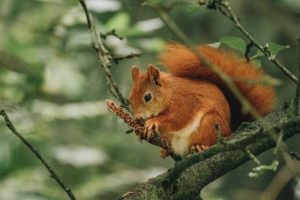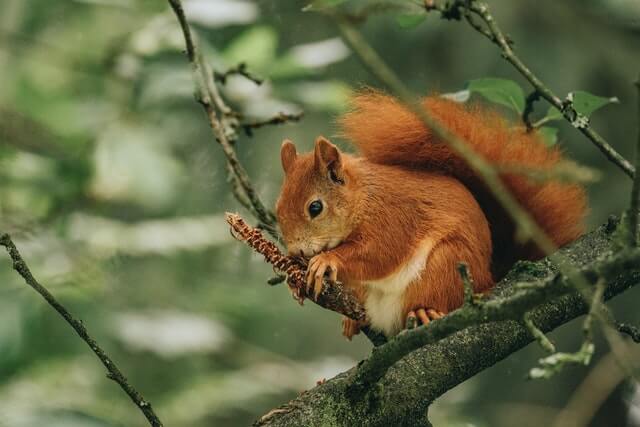Squirrels can be cute neighborhood additions, as long as they stay in trees and yards, but they can be devastating pests when they peel back siding, soffit, and fascia, causing thousands of dollars’ worth of damage each year to home owners.
For all of your squirrel control needs, including squirrel removal and squirrel relocation, look no further than Done Right Pest Solutions
Table of Contents
Types of Squirrels
There are different types of squirrels, just like there are different types of bugs. Each type of squirrel is interested in different things in terms of nesting. They also have different habits and can sound different if one type of squirrel is in your attic.
For example, a ground squirrel or flying squirrel would not be in your attic, so you can eliminate those from the list. If the activity is at night it is most likely a red squirrel, but if the activity is during the day, it is either a gray squirrel or a fox squirrel, two of the most common squirrels in Minnesota and Wisconsin.
Here you can learn brief information and subtle differences within these squirrel families and how best to know which variety you may have infesting your home. Learn more about red squirrels, gray squirrels, flying squirrels, fox squirrels, and thirteen-lined ground squirrels below!
Red Squirrel
Red squirrels are smaller than 50% of a gray squirrel. But let their smaller size not be an indicator of what their presence may be like in your home: red squirrels are very destructive and noisy.
Red squirrels are most common in areas with evergreen trees and other coniferous trees.
These squirrels are most known for their reddish tails, but they do have brownish tinted bodies, with some gray hues in their sides. They have white under bellies and curved ears. Their eyes are bright and their calls are loud and chipper.
They eat seeds and nuts from all kinds of trees, coniferous or deciduous. Red squirrels are smart, adaptive squirrels, as they hide their nuts and seeds for a rainy day, either in the ground or in trees.
Red squirrels are very destructive to homes, should they decide to make their homes in yours. They are nocturnal, which can cause confusion of pest type, as mice and rats are awake at night, too. However, they typically nest in hollow trees, or build a foot to 1.5 feet in diameter ball-shaped nest in tree tops using leaves, twigs, and other materials.
Red squirrels mate in late winter, resulting in females having 2 to 5 babies per litter in early spring. Squirrels, like mice, are born hairless and weigh less than an ounce.
Baby red squirrels grow to adults and can fend for themselves after 3 months.
Red squirrels communicate loudly with other squirrels, but also humans.

Gray Squirrel
Gray squirrels, nicknamed “bushytails” are your average backyard squirrel.
Gray squirrels are, you guessed it, predominately gray in color. They do have white under bellies. And the albino squirrel and black squirrels are in the gray squirrel family.
Gray squirrel tails are about the same size as their bodies (8-10 inches).
These squirrels are often spooked, and as a result have a harsher chatter or chipper to indicate when they are scared or angry.

Gray squirrels eat nuts and seeds, like red squirrels do. But, these squirrels often eat moss and tree buds, while red squirrels do not. If hungry enough, gray squirrels have also been known to be a garden pest, digging up plant and vegetable bulbs and eating your hard work.
Gray squirrels, unlike red squirrels, mate twice per year, between December and February and again between June and August. This results in 2 litters per year, instead of 1. Each litter consists of 2 to 4 babies, which are also born hairless, but instead weigh half an ounce.
Just like the red squirrels, gray squirrels typically nest in hollow trees, or build a foot to 1.5 feet in diameter ball-shaped nest in tree tops using leaves, twigs, and other materials. And their babies also become adults after 3 months.
If you want to sound like a gray squirrel, try clicking 2 quarters together. This makes the high-pitched squirrel chatter they are used to.
Flying Squirrel
Flying squirrels are rarely ever spotted by humans, since they are nocturnal and live in tree hollows. Contrary to their name, they don’t fly, but instead glide between trees, by using the skin flaps connecting their arms to their bodies.
Flying squirrels are smaller than your average squirrels, about the size of a chipmunk. They have olive-brown fur and big eyes, that seem bigger than other squirrels because their bodies are smaller. While other squirrels have mainly 1 hue and then white bellies, the flying squirrel has some patches or trails of white throughout its body, and its tail is white underneath as well.
Flying squirrels eat seeds and nuts, but also berries, small birds, and meat scraps, making this rodent more of a carnivore than an herbivore or frugivore (an animal that derives most of its diet from nuts and seeds).
Depending on the species, they can have 1 or 2 litters of 5 young per year. Northern flying squirrels only mate in the early spring, while southern flying squirrels mate in spring and fall.
Fox Squirrel
The fox squirrel is the most common tree squirrel in Minnesota, as opposed to gray squirrels. A fun fact about these squirrels is that they aren’t very agile. In fact, they commonly fall from trees, though usually they get back up uninjured and fairly unphased. I guess adult squirrels bounce, haha!
 Fox squirrels are distinctive in color, though very slightly. They are more orange-ish, instead of gray, brown, or red.
Fox squirrels are distinctive in color, though very slightly. They are more orange-ish, instead of gray, brown, or red.
Fox squirrels, like gray squirrels, mate twice per year, in the early spring and early fall, resulting in 2 litters of 2 or 3 babies weighing about half an ounce as well.
These squirrels eat primarily nuts, but also enjoy corn, some vegetation, and even garbage.
A fun fact about these squirrels is that they aren’t very agile. In fact, they commonly fall from trees, though usually they get back up uninjured and fairly unphased. I guess adult squirrels bounce, haha!
Thirteen-Lined Ground Squirrel (gopher)
Thirteen-lined ground squirrels are small, gopher-like rodents that have golden yellow to brown fur with stripes and spots going down their backs. They are similar to mice or shrews because though they are 11 inches in length, over one-third of that is their tails.
Female thirteen-lined ground squirrels weigh nearly twice as much as their male counterparts (9 and 5 ounces, respectively).
These gopher-like squirrels hibernate in the winter and mate in the early spring, once they’ve woken up. The females have about 8 babies, much more and doubling, in some cases, of other squirrel types. Some females mate again and have another litter in the fall, while others do not. This is not a determining factor in species type.
The thirteen-lined ground squirrels can often become a yard pest because aside from seeds, they love grasses and roots, but they also eat insects and small lizards.
These ground squirrels are also similar to voles or shrews. If you’re looking for a DIY gopher carbon dioxide machine, call the pros at Done Right Pest Solutions for a free quote: 651-342-9489.
This squirrel variety is, in fact, the gopher that is the mascot for the University of Minnesota.
For other wildlife tips and tricks, check out this category within our blog.
How We Perform Squirrel Control
Each situation is different and requires patience in inspecting and knowledge in trap baiting, placement, and setting. Done Right Pest Solutions has multiple expert technicians who take the time to get the job done right.
Inspection: The technician first inspects the property, determining how the squirrels are getting into your home, garage, or shed. Usually there is either a visible or hidden hole that is the size of a tennis ball.
Baiting: The technician will use a live trap and bait the trap depending on the type of pest, and type of squirrel.
Placement: Placement is key to catching the squirrel(s). The technician will place the trap either within the attic or inside the opening, outside the openings, or occasionally on the roof if needed.
Setting: Setting takes precision. Depending on the situation and type of pest, like if they are cautious or not, the technician may not set the trap right away: kind of lure it in, let it eat and leave, and then rebait and set the trap.
Squirrels are smart and they can track their way back to your home if you don’t take them away far enough. It also helps to travel over bridges, under bridges, over rivers, etc. (try to confuse them). We relocate them at least 10 miles away from your home.
For more information, check out our Squirrel Service page. When we have a gopher burrow that the gophers won’t leave, we can use our carbon dioxide machine. If you’re looking for a DIY gopher carbon dioxide machine, give us a call for top-notch service: 651-342-9489.
For the best DIY pest control methods, check out our category within our blog.
Conclusion & Next Steps
Done Right Pest Solutions is proud to be your one-stop shop for all things pest control and squirrel control. We even trap, remove, and relocate opossums and raccoons too!
Most pest control companies end their service lists at rats, serving only needs in regards to non-vertebrate pests. Done Right Pest Solutions has gone one step farther, obtaining the additional licensure, experience, equipment, and knowledge in squirrel control techniques.
Here you learned a lot about the 5 main types of squirrels in Minnesota and Wisconsin: Red squirrel, gray squirrel, (northern) flying squirrel, fox squirrel, and the thirteen-lined ground squirrel. We also shared how we treat, remove, and relocate squirrels. We are here for all of your squirrel control needs.
Aside from all of our other services offered, we hope you’ll reach out to us if you ever have any squirrel control needs. Squirrel control can be added in to any of our Commercial Pest Control or Multi-Family Housing Pest Control services.
While squirrel control is not included in our Peak Seasons Plan this option is our most comprehensive and most affordable service plan option. If you’re interested in all insect and rodent control, check out the Peak Seasons Plan!
We look forward to taking care of all of you squirrel control needs,
Done Right Team
Have you ever had squirrels in your home or attic? If so, what did you do to get rid of them? We would love to hear of your experience in the comments!
Want to learn more tips and tricks regarding pest control? Subscribe to our free email newsletter.

